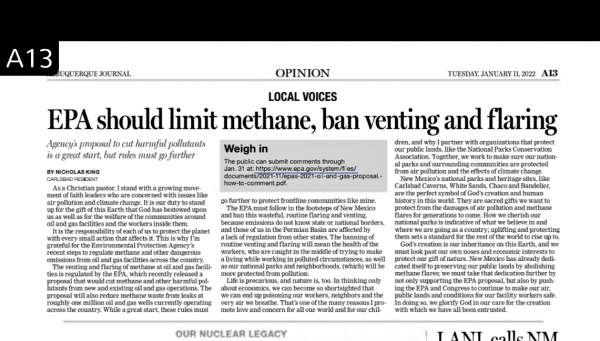The New Mexico Supreme Court today rejected New Energy Economy’s challenges to the constitutionality of the Energy Transition Act (ETA) and upheld the New Mexico Public Regulation Commission (PRC) decision relating to the coal-fired San Juan Generating Station. These rulings end months of delays in sending transition funds to communities and issuing bonds that will reduce customer costs.
The court rejected all of the remaining challenges to the constitutionality of the ETA and concluded that the state legislature properly exercised its authority to set energy policy when enacting the legislation. The court also rejected challenges to the PRC decision to approve a financing order for the transition costs associated with the PNM decision to abandon its interest in the San Juan Generating Station.
“We are grateful that the ETA is continuing to empower communities toward clean energy and a new path forward with our economy. We need to continue to address climate change as we care for our communities and our sacred land, water and air,” Sr. Joan Brown, osf, Executive Director, New Mexico Interfaith Power and Light.
Among the positive outcomes resulting from the Energy Transition Act in its first two years are:
- Replacement of San Juan Generating Station coal with 100% solar and battery storage, providing $1 billion investment in impacted communities;
- PNM relied on the ETA and the PRC’s rejection of gas in the San Juan case to propose a 100% solar and battery replacement for the power served by its expiring lease at Palo Verde nuclear plant;
- PRC denied rate recovery for El Paso Electric’s proposal to expand Newman Gas Plant;
- All investor-owned utilities in New Mexico are on track to provide 40% renewable energy supply by 2025; and to fully decarbonize their energy portfolios by 2045 or earlier;
- Rate savings for customers resulting from the ETA’s low-cost financing of San Juan costs, and its renewable/battery replacement power, are millions less than what customers are paying today for those San Juan assets;
- Millions of dollars in funding for transitioning workers and the communities impacted most by polluting coal will now be able to flow into communities.
Environmental, Community, Tribal, Faith Grassroots Groups Celebrate
“This decision is welcome news. It clears away the obstacles that were keeping support from flowing to communities like Farmington, which desperately need assistance to help in the transition to post-coal economies. That includes funding for innovative clean energy projects that will be such an important part of our rebuilding.” Mike Eisenfeld, Energy and Climate Program Manager, San Juan Citizens Alliance.
“NAVA Education Project thanks the New Mexico Supreme Court for making the decision today to affirm its constitutional responsibility to Navajo workers and communities by upholding the Energy Transition Act. Now that this legal barrier has been lifted, impacted communities will soon have access to the $40 million in Section 16 funding. This action will bring forward a strong diversified economy and emission-free electricity.” Joseph Hernandez, NAVA Education Project, Diné Energy Organizer.
“We are thankful that the New Mexico Supreme Court upheld the ETA. We want healthy communities and economic opportunities that are not fossil fuels based. This decision is a step in the right direction to secure a healthier future for our communities.”
Carol Davis, Executive Director, Diné C.A.R.E.\
“The Energy Transition Act has led to 100% solar and battery replacement of coal power, billion-dollar investments in frontline communities, savings for utility customers and rejection of gas plants and other dirty energy. Today’s Supreme Court ruling affirms the law and allows us to finally move forward on a just climate transition in New Mexico.” Camilla Feibelman, Sierra Club – Rio Grande Chapter, Director.
“WRA is pleased the court has finally put to rest, and rejected, the bogus claims New Energy Economy made about the ETA. Unfortunately, NEE’s advocacy did not come without a cost to communities and workers, who had millions of dollars of important transition funds held up during the pendency of the appeal. The court’s decision now frees up this important funding for worker training and community assistance,” said Steve Michel, deputy director of Western Resource Advocates’ Clean Energy Program.
“This is a great victory for the New Mexico Energy Transition Act. Now all the promises that the ETA has can move forward and the much needed funding can be released to the Communities. New Mexicans have waited too long for Environmental and Climate Justice to protect our New Mexico communities and our beloved and Sacred Land of Enchantment. Let the Energy Transition begin!” Terry A. Sloan, Director, Southwest Native Cultures.
“Today’s ruling affirms that the New Mexico state legislature can establish critical clean energy policies like the Energy Transition Act,” said Noah Long, Western climate and clean energy program director at NRDC (Natural Resources Defense Council). “This legislative session, our state leaders should go even further by speeding up our transition to clean energy, setting binding pollution limits for every sector, and ensuring job opportunities and utility bill savings for working families.”
“The ETA was nation leading when it passed, allocating real life resources for community transition away from fossil fuel sources.” said Conservation Voters New Mexico’s executive director Demis Foster. “The case against it delayed much-needed financial support for tribes, communities and workers in the transition from coal and brought uncertainty to clean energy projects. Now we can move ahead with building a zero emission economy for New Mexicans.”
“Today’s decision is an important milestone in our state’s transition away from fossil fuels and toward a clean energy future,” said Kyle Tisdel, Climate & Energy Program Director with Western Environmental Law Center. “It allows critical transition funding to start flowing into communities that have long-shouldered the burdens from a legacy of fossil fuel exploitation, while accelerating our ability to address the climate crisis.”
“We are grateful that the ETA is continuing to empower communities toward clean energy and a new path forward with our economy. We need to continue to address climate change as we care for our communities and our sacred land, water and air,” Sr. Joan Brown, osf, Executive Director, New Mexico Interfaith Power and Light.
“The communities feel that they’re ‘a sacrifice zone’ and are continually ‘a sacrificed zone,’ ” Brown said. “They’re suffering from pollution now. Everybody else is using their energy. And yet with this transition, where are the jobs going to come from?”

